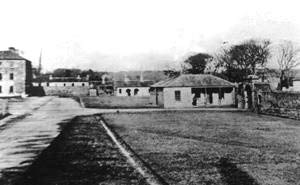
Official reports say they were brought to Dublin from Templemore. Richmond Barracks in Templemore had been used as a POW Camp for German prisoners at the start of the war, but they were soon moved to England. After the German prisoners had departed, Richmond Barracks became a large training depot for Irish recruits joining the British army, particularly the Royal Munster Fusiliers, the Leinster Regiment. & the Royal Dublin Fusiliers. Thousands of Irishmen were trained in Templemore.

Templemore Barracks in 1916
Sir John French reported During the day the 4th Royal Dublin Fusiliers from Templemore, a composite Ulster battalion from Belfast, and a battery of four 18-pounder guns from the Reserve Artillery Brigade at Athlone arrived, and this allowed a cordon to be established round the northern part of the city from Parkgate, along the North Circular Road to North Wall. Broadstone Railway Station was cleared of rebels, and a barricade near Phibsborough was destroyed by artillery fire. .
The first actual entry of the military in force from an outside area took place on Tuesday evening, when a body of Royal Dublin Fusiliers from Templemore Barracks forced their way into the centre of the city by Cabra Road. 4th Dublins fought the rebels along the railway line from the Broadstone railway station (which the rebels had taken over) up to the Cabra Bridge. The insurgents had placed barricades both on the Park Road and on Cabra Road, near the point at which Charleville Road links up these thoroughfares. Houses overlooking the barricades were occupied by the insurgents, and some brisk fighting took place before the way was cleared for the military advance. A well-directed shell or two demolished the barricades, and within a short time the defenders, under the thunder of artillery, machine guns and rifle-fire, were forced from these positions. There were a couple of civilian casualties resulting from the shrapnel. Attempts by the insurgents to blow up the Cabra Bridge and the bridge crossing the Midland Railway on the North Circular Road beyond Phibsborough Church were unsuccessful. The insurgents who were not wounded, killed or taken prisoners fled across country towards Finglas and Glasnevin.
As a result of this a strong military cordon was drawn around the whole district, and even people attending funerals were not allowed to pass. All the streets in Drumcondra and Phibsborough held snipers, and the military were compelled to exercise great care in their advance. But with the help of their machine guns they made steady progress from day to day. From Wednesday until the insurrection ended, all traffic was held up between the northern suburbs and the heart of Dublin.
A detachment of 4th Battalion is also reported as being in Dublin Castle
2nd Lt George R GRAY Killed on 28 April 1916 Age 21 Buried Grangegorman Military Cemetery. Son of the late Alexander and Helen Ross Gray, of Newcastle-on-Tyne. A Dental Student. Age 22. 4th Battalion